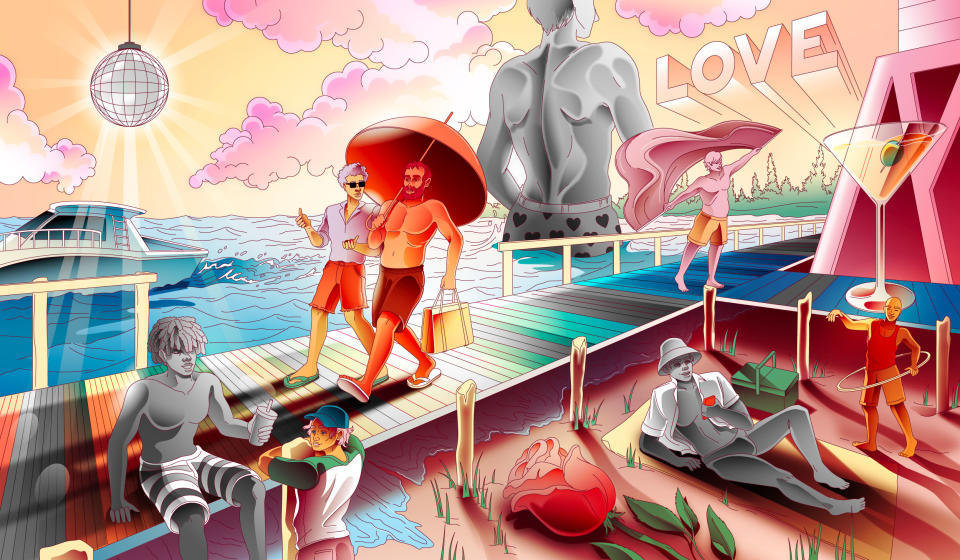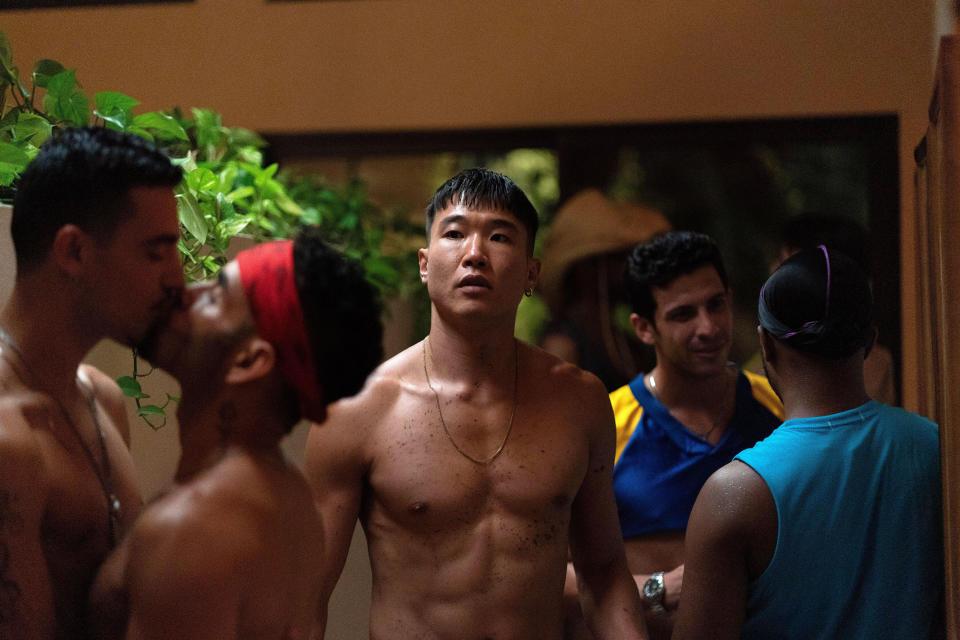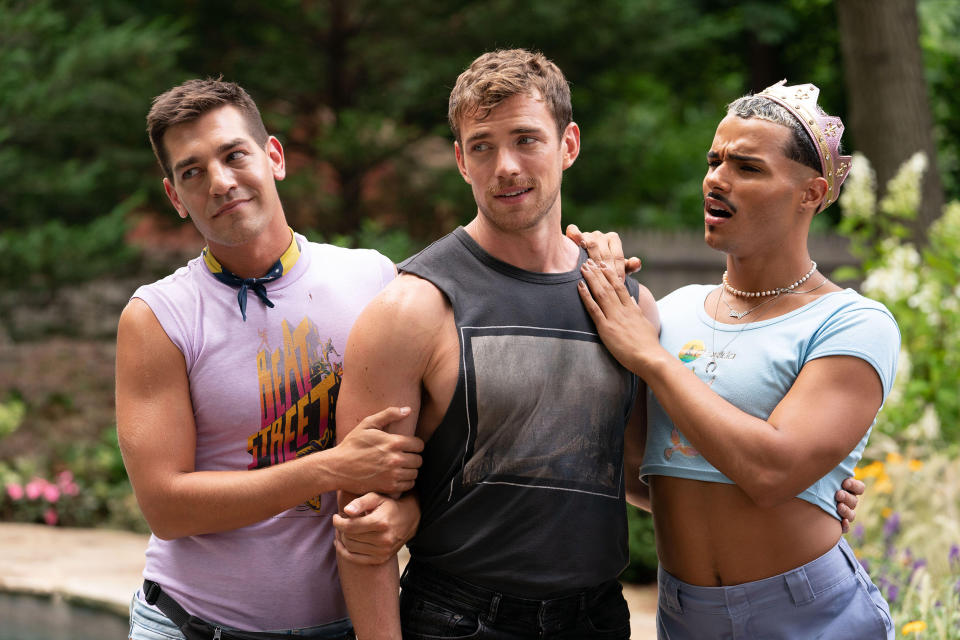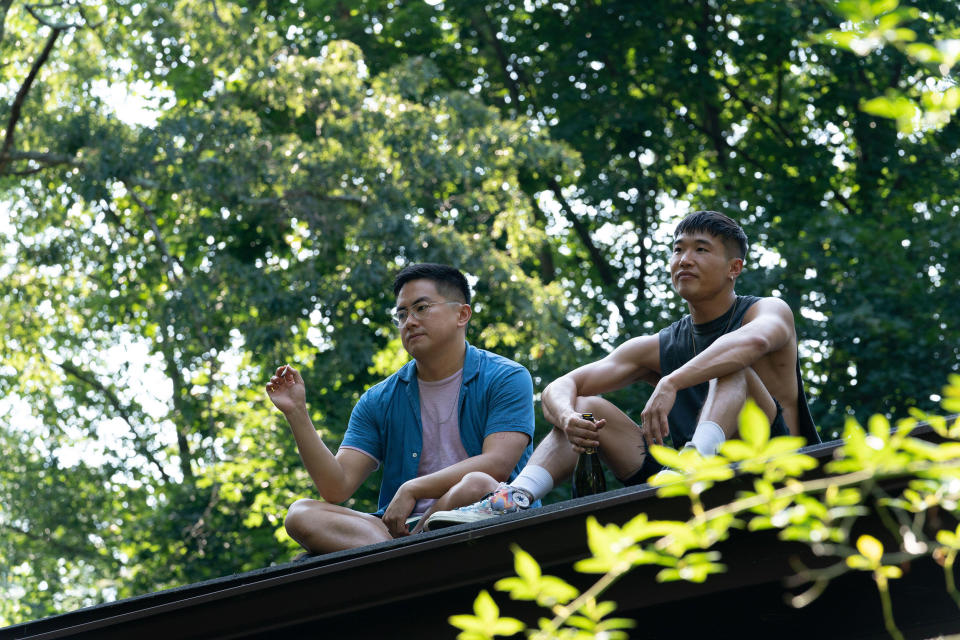What the movie 'Fire Island' gets right, according to a gay man who actually goes there
When I first started going to Fire Island in 2016, I didn’t really know what to expect of the iconic gay destination 50 miles east of New York City, accessible only by ferry.
I had heard sordid stories from some older gay men on the pleasures that awaited me there: days by the beach and nights by the bar. But the sandbar is cloaked in mystery for anyone who hasn’t had the opportunity to set foot on its shores.
There are no cars?
The streets are boardwalks?
You don’t really drink tea at tea?
After one weekend, I fell in love, and every summer since — excluding a pandemic one here or there — I’ve spent countless weekends in a share in one of the more infamous houses in the Pines, the island community comprised of predominantly gay men.
In fact, as I write this, I’m coming down from a long weekend just spent at the Pines. I’m quick to try and share my experiences with my friends or family who have never been, but it’s nearly impossible to explain the magic or joy that awaits you.

Luckily, there’s a new film that is tackling the seemingly impossible task of telling this place’s story on film — and it really does hold up. Directed by Andrew Ahn, “Fire Island” was written by Joel Kim Booster and is now streaming on Hulu.
The project first took the form as a limited series written for the short-lived streaming platform, Quibi. Luckily, Fox Searchlight bought Booster’s script, and filming began in 2021 with an all-star LGBTQ cast featuring “Saturday Night Live” wunderkind Bowen Yang, Margaret Cho, Matt Rogers and Conrad Ricamora.
“With this film, I really wanted people to know that as queer people we don’t always get the support that we need from our families and so we build our chosen families — and that’s something really beautiful and worth celebrating,” Ahn told TODAY at the New York City premiere event that kicked off Newfest Pride, a five-day LGBTQ film festival tied to Pride Month.

I admit I went into “Fire Island” secretly wanting it to hate it. They can’t possibly capture my fabulous life on film! In my experience, gay men tend to have a proclivity to hate the work of other gay men (unless they’re maybe a drag queen), and even I can fall victim to a jealous eye-roll now and again. But here in this film, the creators manage not only to capture the essence of the island on film, they do it well. I had no choice but to cheer along.
“It’s choose your own adventure,” Booster told TODAY of the actual place, where the movie was also filmed. “You can have a wild night or you can sit at home and play board games with your friends if you want. It is whatever you make of it.”
A remix of Jane Austen’s “Pride and Prejudice,” the film “Fire Island” — streaming on Hulu on June 3 — follows five friends taking their annual pilgrimage for one week. Yang told TODAY, “They come in with preconceived notions about intimacy or how they relate to other queer people and whether or not they belong in a queer space.”

Loosely modeled off the five Bennet sisters of Austen's novel, this self-described chosen family ticks off boxes of different type of stereotypes in the community: the intellect (Torian Miller), the circuit queen (Booster), the musical theater dropout (Rogers), a "sickening nonbinary fairy" (as actor Tomas Matos describes his character) and the overlooked hopeless romantic (Yang).
They’re staying at a crunchy granola oasis belonging to Cho’s character Erin, an eccentric older lesbian who offers sage advice and a place for them to call home. On the ferry ride there, the five boys bask in the excitement of traveling somewhere where they won’t see a straight person for a week.
The movie's exterior shots were filmed in Fire Island during the summer of 2021. The film shows off the island's serene landscape, as well as swanky and architecturally lauded pads, revered by experts as some of the most beautiful examples of mid-century modern style in the United States.
Most of the interior shots, however, weren’t filmed on location. Instead, designers perfectly replicated storied spots like the Pavilion nightclub in the Pines or the Ice Palace gay bar in Cherry Grove, where a drag show and an underwear party were excellently recreated — proving the creators knew their way around those dark rooms in real life.
“When we went to the recreated Ice Palace and Pavilion, it was so meta. The underwear party was wild,” Rogers told TODAY. “(The crew) did an incredible job. I shot the movie, and even when watching it I almost had forgotten what was real and what was fake.”
Conflict arises when they encounter a group that couldn’t be more opposite from them, from their bank accounts to their body types. Still, attraction abounds.
Yang falls head over heels for a preppy doctor (James Scully), while Booster struggles with a lawyer (Ricamora) who definitely has his foot up his a--, a la Mr. Darcy in "Pride and Prejudice."
The film shows that while there aren't straight people around to judge them for being queer, hierarchies and classism still rear their heads relentlessly, dividing people in a place where everyone shares a major commonality.
Toxicity — especially aimed at marginalized groups like Black, brown and Asian men — is also highlighted, showing the awful treatment these groups often have to endure under the guise of sexual preference. The two leads are both Asian. While this similarity connects their characters in many ways, they also have trouble empathizing with one another because their realities are so different. Just as the film shows there's no single gay experience, there's also no single Asian experience, too.

But the film doesn’t just live that in trauma. It celebrates the power of self-love and more importantly, self-acceptance, as well as the ways friends can be instrumental in those awakenings.
The ending has the cheesy but satisfying payoff of a ‘90s rom-com, which LGBTQ people never really got the chance to see themselves in until recently. When Donna Summer’s iconic “Last Dance” plays as the credits begin to roll, anyone — straight or gay — will get a chill on their forearm or a tear in their eye at the film’s heartwarming message.
“By the end, everyone feels like they can belong together even with their different points of views,” Yang said. “That Fire Island is a multitudinous place. There’s a place for everybody, there’s a corner for everyone if they can carve that out.”
Above all, it makes a seemingly unattainable place a little more accessible to people who may never have the time or resources to get there themselves. There’s nothing like experiencing the magic of the Pines in real life, but watching “Fire Island” may be the next best thing.
To celebrate LGBTQ pride, TODAY is sharing this community’s history, pain, joy and what’s next for the movement. We will be publishing personal essays, stories, videos and features throughout the entire month of June.

